Reality capture, also known as 3D scanning or 3D imaging, is creating a digital representation of a physical space or object. It involves using specialized equipment, such as laser scanners or cameras, to capture the geometry and appearance of the environment in a highly detailed and accurate manner. In real estate, reality-capture has become increasingly popular and valuable. In this article, we are going to go over some of the reasons why:
Photo by Valentin Antonucci from Pexels
1. Accurate and Detailed Representations
Reality-capture offers a level of detail and accuracy that traditional methods, such as hand measurements or photographs, cannot achieve. This allows real estate professionals to create highly accurate floor plans, models, and virtual tours of properties, ensuring potential buyers or tenants clearly understand the space.
2. Remote Visualization
With reality-capture, interested parties can explore properties remotely. This is especially beneficial for out-of-town buyers or international investors who want to get a sense of the property without physically visiting it. They can navigate through the digital model, measure distances, and evaluate the layout from the comfort of their location.
3. Time and Cost Savings
Reality-capture streamlines the documentation process and reduces the time required for measuring and photographing properties. It also eliminates the need for multiple site visits, as all the necessary information and details are captured in one go.
This can save real estate professionals and clients significant time, enabling them to focus more on decision-making and negotiations.
4. Enhanced Marketing Materials
The detailed and immersive nature of reality-capture allows real estate agents to create visually stunning marketing materials. Virtual tours, 3D walk-throughs, and interactive models attract more attention and offer a more engaging experience for potential buyers or tenants. This can result in increased interest, higher conversion rates, and quicker sales or rentals.
5. Improved Property Management
Reality-capture is not only beneficial for marketing properties, but it also provides value during the property management phase. By creating accurate digital models, property managers can easily track and document changes, conduct virtual inspections, and plan maintenance or renovations more efficiently.
This leads to enhanced communication, reduced operational costs, and better overall management of real estate portfolios.
6. Future-proofing
Reality-capture data can be stored and used for future reference or updates. This is particularly useful for properties requiring regular inspections, such as heritage buildings or ongoing development projects. By having a comprehensive digital record of the property, any changes or updates can be accurately documented and compared over time.
Since immersive visual experiences have become increasingly popular in recent years, thanks to advancements in reality-capture technology, these tips and tricks will help you take your immersive visual experiences to the next level.
7. Choose the Right Equipment
Invest in high-quality cameras and other necessary equipment to capture immersive visuals. This will ensure better image quality and accuracy in capturing the environment.
8. Plan Your Capture Process
Before starting, create a detailed plan for capturing the visual experience. Consider factors like lighting conditions, camera positions, and capturing different perspectives to provide a comprehensive experience.
9. Use a Tripod or Stabilizer
To maintain image stabilization and avoid blurry visuals, use a tripod or stabilizer when capturing. This will result in smoother and more professional-looking visuals.
10. Experiment with Different Angles and Perspectives
Capture the visual experience from multiple angles and perspectives to create a more immersive and engaging outcome. This can be done by positioning the camera at different heights and distances or even using drone cinematography for aerial shots.
11. Pay Attention to Lighting
Proper lighting is critical for capturing high-quality visuals. Consider the natural lighting conditions of the environment or use artificial lighting techniques to enhance the visual experience.
12. Consistency is Key
Maintain consistency in camera settings, exposure, and white balance throughout the capture process. This provides a cohesive visual experience without jarring transitions between clips or images.
13. Edit and Post-process
After capturing the visuals, use editing software to enhance the overall look and feel of the experience. Adjust brightness, contrast, and color grading to ensure a visually appealing result.
14. Incorporate Sound
Immersive visual experiences can be further enhanced by incorporating sound effects or background music. This can create a more holistic sensory experience for the viewer.
15. Consider Storytelling
To create a truly immersive visual experience, consider the narrative or story you want to convey. Incorporate storytelling elements or create a sequence of visuals that tells a compelling story.
16. Optimize for Different Platforms
Optimize the output for different platforms when sharing the immersive visual experience online or on social media. Consider the aspect ratio, file size, and compatibility to ensure maximum engagement and accessibility for viewers.
Bottom Line
In today’s digital era, where technology continues transforming our everyday interactions, reality-capture stands out as a groundbreaking tool for the real estate sector.
By integrating the aforementioned tips and tricks, professionals can fully harness the potential of reality-capture, providing prospective buyers, tenants, and stakeholders with rich, engaging visual narratives.







